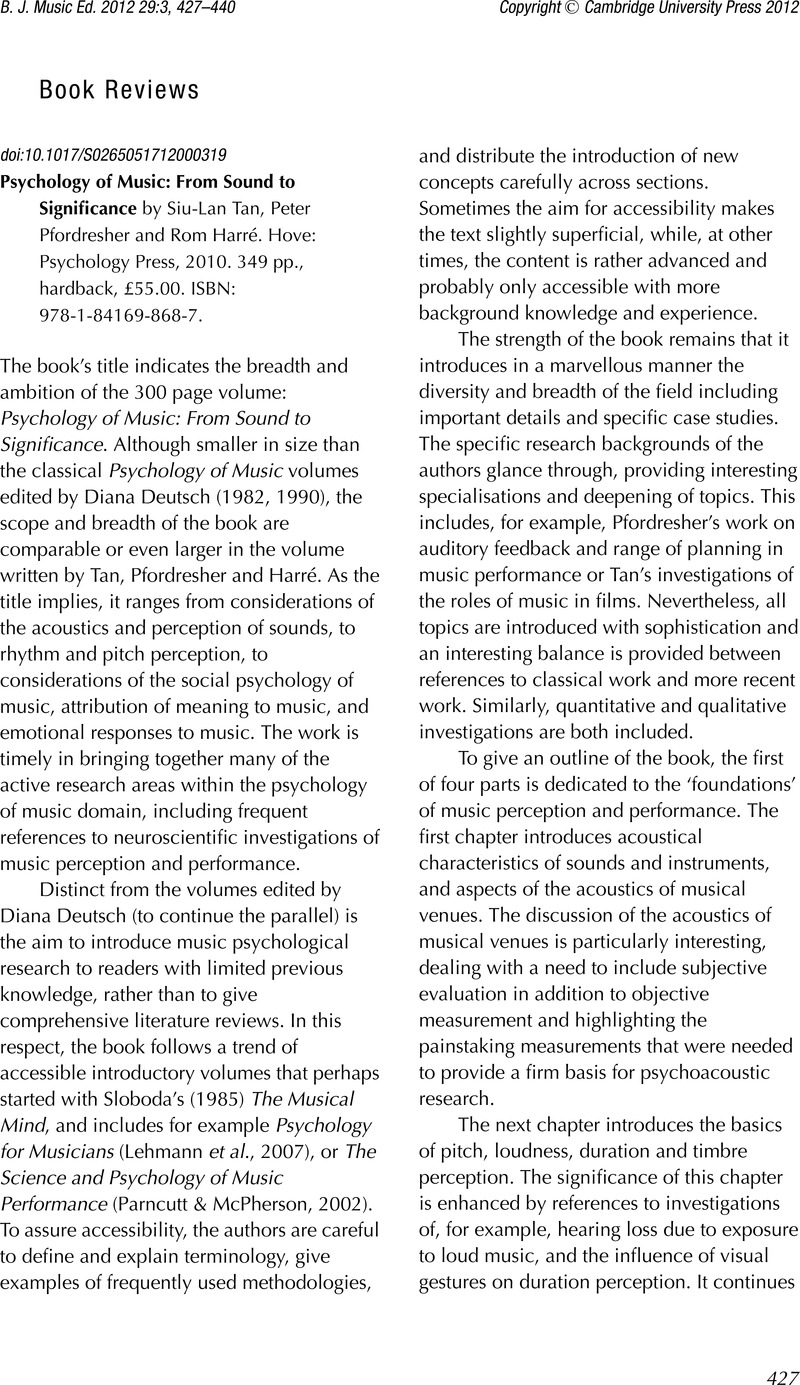No CrossRef data available.
Article contents
Psychology of Music: From Sound to Significance by Siu-Lan Tan, Peter Pfordresher and Rom Harré. Hove: Psychology Press, 2010. 349 pp., hardback, £55.00. ISBN: 978-1-84169-868-7.
Published online by Cambridge University Press: 29 November 2012
Abstract
An abstract is not available for this content so a preview has been provided. Please use the Get access link above for information on how to access this content.

- Type
- Book Review
- Information
- Copyright
- Copyright © Cambridge University Press 2012
References
DEUTSCH, D. (1975) Two-channel listening to musical scales. Journal of the Acoustical Society of America, 57, 1156–1160.Google Scholar
DOWLING, W. J. (1978) Scale and contour: two components of a theory of memory for melodies. Psychological Review, 85, 341–354.CrossRefGoogle Scholar
HEVNER, K. (1936) Experimental studies of the elements of expression in music. American Journal of Psychology, 48, 246–268.Google Scholar
HURON, D. (2006) Sweet Anticipation: Music and the Psychology of Expectation. Cambridge, MA: MIT Press.CrossRefGoogle Scholar
KRUMHANSL, C. L. (1979) The psychological representation of musical pitch in a tonal context. Cognitive Psychology, 11, 346–374.Google Scholar
LANGER, S. (1953) Feeling and Form: a Theory of Art Developed from ‘Philosophy in a New Key’. London: Routledge & Kegan Paul.Google Scholar
LEHMANN, A. C., SLOBODA, J. A. & WOODY, R. H. (2007) Psychology for Musicians: Understanding and Acquiring the Skills. Oxford: Oxford University Press.Google Scholar
LERDAHL, F. & JACKENDOFF, R. (1983) A Generative Theory of Tonal Music. Cambridge, MA: MIT Press.Google Scholar
MEYER, L. B. (1956) Emotion and Meaning in Music. Chicago, IL: University of Chicago Press.Google Scholar
LEVITIN, D. (2008) The World in Six Songs: How the Musical Brain Created Human Nature. New York, NY: Dutton.Google Scholar
NARMOUR, E. (1992) The Analysis and Cognition of Melodic Complexity: The Implication–Realization Model. Chicago, IL: University of Chicago Press.Google Scholar
PARNCUTT, R. & MCPHERSON, G. E. (2002) The Science and Psychology of Music Performance: Creative Strategies for Teaching and Learning. Oxford: Oxford University Press.Google Scholar
SCHENKER, H. (1906/1954) Harmony. (Borgese, E.M., Transl.). Chicago: Chicago University Press.Google Scholar
SLOBODA, J. A. (1985) The Musical Mind: The Cognitive Psychology of Music. Oxford: Clarendon.Google Scholar
SWANWICK, K. & TILLMAN, J. (1986) The sequence of musical development: a study of children's composition. British Journal of Music Education, 3, 305–339.CrossRefGoogle Scholar




